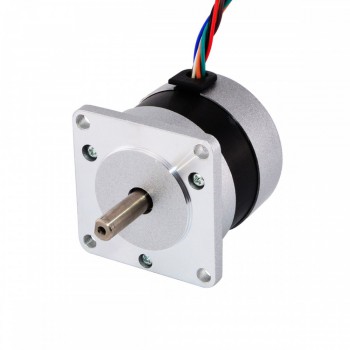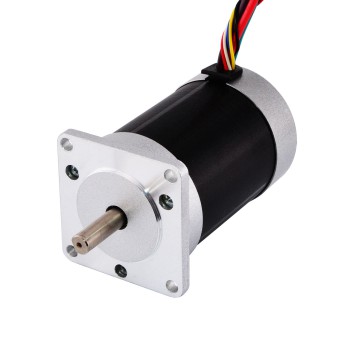Operating characteristics of brushless DC motors
2024/08/29 16:52
瀏覽42
迴響0
推薦0
引用0
1.A brief introduction to brushless DC motors
A brushless DC motor (BLDC Direct Current Motor) is a synchronous motor that uses a direct current (DC) power supply. It is also called an electronically commutated motor (ECM or EC motor) or a synchronous DC motor. This motor converts the DC power supply into a three-phase AC power supply through an inverter and is a permanent magnet synchronous motor with position feedback. The brushless DC motor uses an electronic commutator to replace the traditional mechanical commutator, so it has many advantages, such as high efficiency, low noise, long life and no sparks. The working principle of the brushless DC motor is to perform electronic commutation through built-in sensors and electronic commutators to eliminate the wear of the brushes and the noise generated by the contact of the brushes. This motor integrates the advantages of DC motors and AC motors, and has the good speed regulation performance of DC motors, as well as the simple structure, reliable operation and easy maintenance of AC motors.
2.Control principle of brushless DC motors
1.Electronic commutation: The brushless DC motor uses built-in sensors and electronic commutators for electronic commutation, which is to eliminate the wear of the brushes and the noise generated by the contact of the brushes. The controller provides direct current in all directions to convert the direction of the winding current and realize electronic commutation.
2.Interaction between magnetic field and current: The brushless DC motor uses the interaction principle between the energized coil and the permanent magnet to achieve rotation. When the coils (stators) on both sides are energized, it can be seen from Amperes law that the two energized coils will generate a magnetic field in the right direction. At this time, the permanent magnet (rotor) in the middle will try to make the direction of its internal magnetic induction line consistent with the direction of the external magnetic induction line, forming a shortest magnetic closed loop, so that the permanent magnet rotates clockwise.
3.Three-phase star connection: The stator winding of the brushless DC motor adopts a three-phase star connection, plus a rotor position sensor. By switching the power-on sequence of the three-phase winding in a reasonable order, the rotor can be rotated with the magnetic field.
4.The role of the controller: The controller plays a key role in the brushless DC motor. It adjusts the current direction and size in the stator winding in real time according to the rotor position signal through the control of the power electronic switching device, thereby accurately controlling the torque and direction of the motor.
3.Design and research direction of brushless DC motors
1.Selection of motor phase number, body structure, winding structure and slot-pole number combination: According to the design requirements of the drive motor, the motor phase number, motor body structure, winding structure and slot-pole number combination are first analyzed in detail. This step is to ensure the rationality and effectiveness of the motor design.
2.Design of permanent magnet and air gap length: The permanent magnet and air gap length are designed through relevant formulas, which is a key step to ensure the performance of the motor.
3.Calculation and determination of motor armature diameter, core length, stator structure and rotor structure: According to the design parameters, the motor armature diameter, core length, stator structure and rotor structure are calculated and determined, which is the basis for building the motor physical model.
4.Finite element model establishment and characteristic analysis: A two-dimensional finite element model is established according to the design parameters, and no-load and load characteristic analysis is performed to verify the rationality of the design scheme.
5.Multi-objective optimization: Genetic algorithm is used to optimize the motor for multiple objectives. The effectiveness of the optimization process is verified by comparing the efficiency, output power, loss, average torque, torque pulsation and cogging torque pulsation of the motor before and after optimization.
6.Core loss model analysis: The core loss model is analyzed, and a core loss calculation model that considers alternating magnetization, rotating magnetization and harmonic magnetic field is used to accurately calculate the stator core loss.

4.Operation characteristics of brushless DC motor
1.Good external characteristics and high torque output at low speed: The design of brushless DC motor enables it to provide large starting torque at low speed, which is very important for applications that require fast start and response.
2.Wide speed range and full power operation: No matter what speed the motor runs at, the brushless DC motor can maintain full power operation, which makes it perform well in application scenarios with large speed changes.
3.High efficiency and strong overload capacity: Brushless DC motors have high efficiency and strong overload capacity, which is particularly important in traction systems, and can ensure efficient operation and strong load capacity of the system.
4.Good regenerative braking effect: Since the rotor of the brushless DC motor is made of permanent magnet material, the motor can enter the generator state during braking to achieve energy recovery, which is of great significance for energy saving and safety.
5.Small size and high power density: The design and manufacturing technology of the brushless DC motor makes it smaller and has higher power density, which is very beneficial for space-constrained applications.
6.High reliability: The fully enclosed structure can effectively prevent dust from entering the motor and improve the reliability and durability of the motor.
7.Simple drive control: Compared with asynchronous motors, the drive control of brushless DC motors is simpler, which reduces the complexity and maintenance cost of the system.
8.Large speed regulation range and easy to achieve variable frequency speed regulation: The brushless DC motor has a large speed regulation range and is easy to achieve variable frequency speed regulation to meet application scenarios with different speed requirements.
9.Strong anti-interference ability: Due to its compact structure and small inductance, radio frequency interference and other electrical oscillations are not easy to occur, which improves the stability and versatility of the system.
10.High operating stability: It is not very sensitive to changes in ambient temperature and will not be affected by temperature changes, ensuring the stability of motor operation.
自訂分類:不分類
上一則: Methods to reduce the noise of planetary gearboxes下一則: Working principle and design features of stepper motor brake
你可能會有興趣的文章:
- Structure and application significance of harmonic reducer gearbox
- Selection criteria for helical planetary gearboxes
- The structure and application fields of linear stepper motors
- Methods to reduce the noise of planetary gearboxes
- Working principle and design features of stepper motor brake
- The difference between two-phase, three-phase and four-phase stepper motors
限會員,要發表迴響,請先登入



